Just as we showed our empathy for the helpees by responding to the content of their expressions, we may show our understanding of their experiences by responding to the feelings that they express. Indeed, responding to content prepares us to respond to the feelings of the helpees’ expressions. Responding to feelings is the most critical single skill in helping because it reflects the helpees’ affective experience of themselves in relation to their worlds.
Helpees may express verbally and directly those feelings that dominate them, or the helpees may express their feelings indirectly, through their tone of voice or by describing the situation in which they find themselves.
Whether the helpees’ expressions are direct or indirect, our goal, as helpers, will be to explicitly show the helpees our level of understanding of their feelings by formulating a response to their feelings. This will give the helpees a chance to check out our effectiveness as helpers. It will also give us a chance to check our own level of accuracy.
Responding to feelings involves asking and answering the empathy question and developing interchangeable responses to feelings.

RESPONDING TO FEELING
To respond to the helpee’s feelings, we must first observe personal behaviors. In particular, we must pay attention to tone of voice and postural and facial expressions. These self-expressions will tell us a great deal about how helpees experience themselves and will be valuable clues to their inner feelings.
Next we must listen carefully to the helpee’s words. Now that we have observed and listened, we must summarize what we have seen and heard with a response that indicates the helpee’s feelings. We do this by asking ourselves the question, “If I were the helpee and I were doing and saying these things, how would I feel?” In answering this question, we first identify the general feeling category (happy, angry, sad, confused, scared, strong or weak) and the intensity of the feeling (high, medium or low). Then we select a feeling word or phrase that fits the feeling category and level of intensity. Finally, we check the feeling expression with our observations to determine if it is appropriate for the helpee involved.
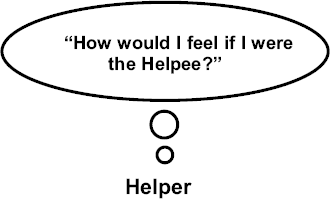
ASKING THE EMPATHY QUESTION
By answering the empathy question we try to understand the feelings expressed by our helpee. We summarize the cues to the helpee’s feelings and then answer the empathy question “How would I feel if I were the helpee?” Let’s ask and answer the empathy question about Tom.
| Tom: | “Things are not going so good for me. Not in school. Not with my girl. I just seem to be floundering. I fake it every day, but inside I’m really down because I’m not sure of what I want to do or where I want to go.” |
The main cue to Tom’s feelings is that he says he feels down. He’s down about school and down about his relationship with his girl. He’s also floundering. If we were in his position, we might very well feel sad.
To everyday life expressions, practice asking and answering the “How would I feel if I were the helpee?” question.

ANSWERING THE EMPATHY QUESTION
We can ensure that we respond to the helpee’s feelings when we make a response that is interchangeable with the feelings expressed. It certainly is not too much to expect that we be able to communicate to the helpee what the helpee has communicated to us. Understanding what the helpee has expressed—at the level it was expressed to us—constitutes the basis of communication and makes helping possible.
A response is interchangeable with feelings if both the helper and the helpee express the same feeling.
The first response to feeling that we formulate should involve very simple feeling words to reflect the feelings expressed by the helpee. We may do this by using a simple “You feel _________” formulation. Before we move to more complex communication, we must learn to formulate simple responses.
We may say that we respond to the helpee’s feelings when we capture and communicate the essence of the helpee’s feelings in one or more feeling words.
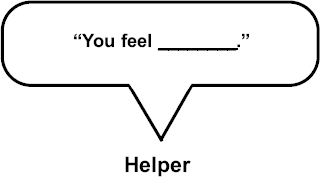
DEVELOPING INTERCHANGEABLE RESPONSES TO FEELINGS
Now let’s try to formulate a feeling response to a helpee’s expression. Let’s repeat Tom’s expression again:
“Things are not going so good for me. Not in school. Not with my girl. I just seem to be floundering. I fake it every day, but inside I’m really down because I’m not sure of what to do or where I want to go.”
We ask ourselves, “How would I feel if I were Tom?” We answer, “Sad—I would feel sad.” Now we formulate the response in a way that communicates directly how he feels: “You feel sad.”
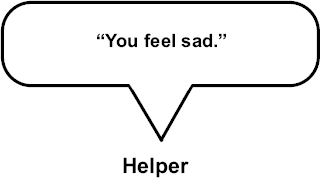
RESPONDING TO SAD FEELINGS
Helpees exhibit many different moods—many different feeling states. Sometimes they seem very sad. Sometimes they seem very happy. Sometimes they seem very angry. Most times they are somewhere in between these extremes.
We must have responses that communicate to them our understanding in each of these moments. We must be able to formulate simple and accurate responses to their feeling states.
For example, Tom is kind of sad or “down.” His energy level appears low. Things seem pretty hopeless. He feels helpless in the face of everything. He just does not know where he is going. Tom verbalizes this feeling when he says, “Sometimes I just think that I’m not going to make it.”
Using an appropriate feeling word for this kind of sadness, we might formulate a simple response.
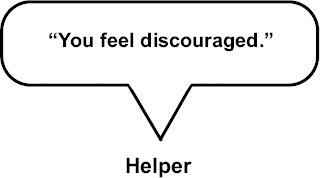
RESPONDING ACCURATELY TO SAD FEELINGS
In rare moments, our helpees might be “up,” particularly when they have found some direction, however tentative. Their whole demeanor changes. Their attitude toward life opens up. Their behavior is intense and brisk.
It is just as important to be able to respond to the helpees in these “up” moments as it is to respond to them in their depressed moments. Indeed, it is ultimately more important to celebrate and reinforce joyful, positive experiences.
While it is critical to “meet” our helpees at the level that they are expressing themselves, we must ultimately help them to move to new and more rewarding behavior. We cannot help them to move if we cannot also respond to those rare moments of joy.
For many of us, these are the most difficult experiences to respond to. Sharing another’s joy is difficult indeed for those of us whose own moments of joy are few and far between.
For example, sometimes Tom’s feelings are so intense that he blurts them out: “I can’t wait to get started!” We might formulate a simple response to his feeling state.
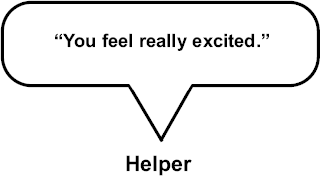
RESPONDING ACCURATELY TO HAPPY FEELINGS
At times, the helpees might express other kinds of feelings, ones that might be difficult to respond to. Sometimes they are just mad at the world, angry with its injustice and motivated to retaliate. Their bodies are tense, their eyes tearing and their expressions choked. Often we are afraid to open up such feelings. We are afraid of how far these feelings may carry them. Will they act upon them? Will they act them out? These are the questions that characterize our concern.
Nevertheless, we cannot help if we cannot deal with all of a person’s feelings. Suppose Tom, our helpee, has been treated unfairly by someone and is very upset. Our helpee must get these feelings out in the open if he is going to learn to deal with them. Indeed, the probability of his acting upon angry feelings is inversely related to his ability to explore them. The more he explores them, the less likely he is to act destructively. Put another way, the more he explores them, the more likely he is to channel them constructively. Sometimes he expresses his feelings in violent terms: “I know damn well I’m gonna get back at him any way I can!” We may formulate a simple response to him.
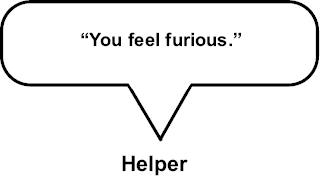
RESPONDING ACCURATELY TO ANGRY FEELINGS
We must respond to our helpees in all their fullness—in their moments of sadness, happiness and anger. They are how they feel. If we do not respond to our helpees in their fullness, the implications are clear: if we cannot find them, we lose them; if we lose them, they cannot find themselves.
There are many variations of feeling themes. Some major themes are surprise, fright, relief, distress, affection, disgust, interest and shame. There is a wide range of more specific feeling states to which we can respond. We must learn to respond to these unique feelings.
It is beneficial for both the helper and the helpee to struggle to capture in words the uniqueness of the helpee’s experiences. Finding the most accurate feeling words may not be easy at first. You may say to yourself, “I just don’t ordinarily use that many feeling words. I don’t know if I can respond accurately.” You will need to expand your feelingword vocabulary.

RESPONDING TO UNIQUE FEELINGS
The more feeling words we have available to us, the better our chances of accurately communicating our understanding of the helpees and their unique experiences.
One effective way of organizing feeling words is to categorize them according to whether they are of high, medium, or low intensity. Since the intensity of any word depends upon the person with whom it is used, we will need to visualize the typical helpees we work with. Then we can determine both the feeling category and the level of intensity that we wish to employ. We may develop our own word list by filling in page 115. Appendix A contains an alphabetical listing of feeling words from which to draw. We may carry a list around with us and add to it. It will help us to learn to respond accurately.

EXPANDING RESPONSES TO FEELING
Based upon the cues we receive from our observations and from the helpee’s initial statements, we attempt to determine the “general feeling category” of the helpee’s feelings. Our next task is to fine-tune our understanding of the helpee’s feelings. We want to find feeling words that are interchangeable with our helpee’s experience. If we are having difficulty finding the “right words” but know we are in the “ballpark,” we can try the following technique.
We begin by simply completing this statement: “When I feel ________ (general feeling), I feel ________ (specific feeling).” This will help us to find a more accurate interchangeable response to feeling.
For example, if the helpee says, “I feel depressed,” and we find ourselves at a loss for a new, more accurate word with which to respond, we might say to ourselves, “When I feel depressed, I feel ________.” We might complete this statement with “lost.” “When I feel depressed, I feel lost.” Look at and listen to the helpee. Does the helpee look and sound “lost”?
We continue to recycle this process and check out new feeling words until we have found an interchangeable feeling word.

FINDING AN APPROPRIATE FEELING WORD
The helpees’ feelings are at the heart of their experience of the world. For better or worse, human feelings are perhaps the most fundamental characteristics of human experience. They are aroused by what we do and what is done to us; they are reflected in what we subsequently do and think; they condition how we act toward others and how we treat ourselves.
Our feelings and the feelings of our helpees are real—for better or worse. And it is with the helpees’ feelings that the helper must relate.
We may wish to practice responding to feelings. We can respond to real-life situations or recordings. The case studies in this text and the exercises in the student workbook may provide helpful stimulus materials for practice in formulating feeling responses.
FACILITATING EXPLORING OF FEELING

